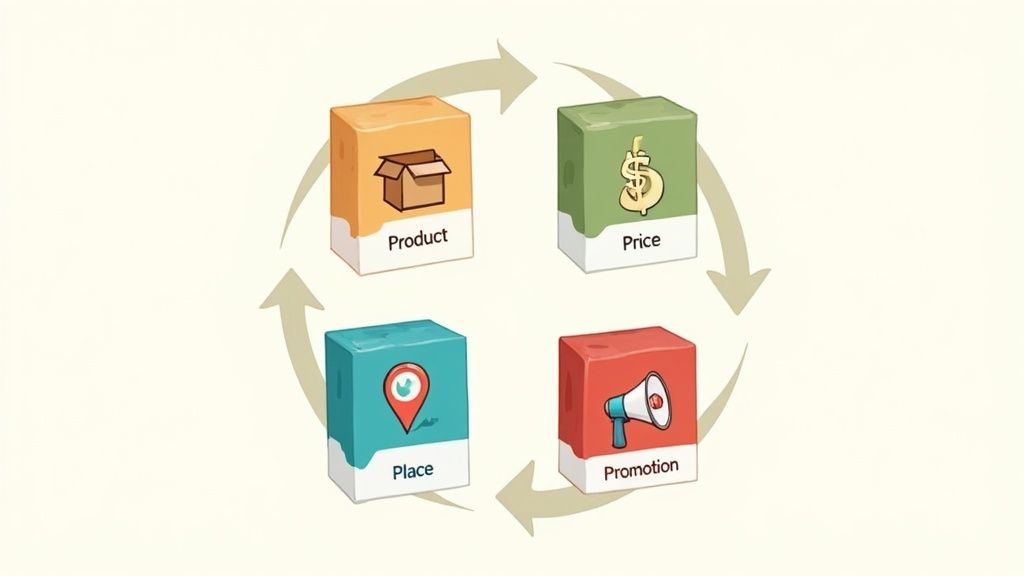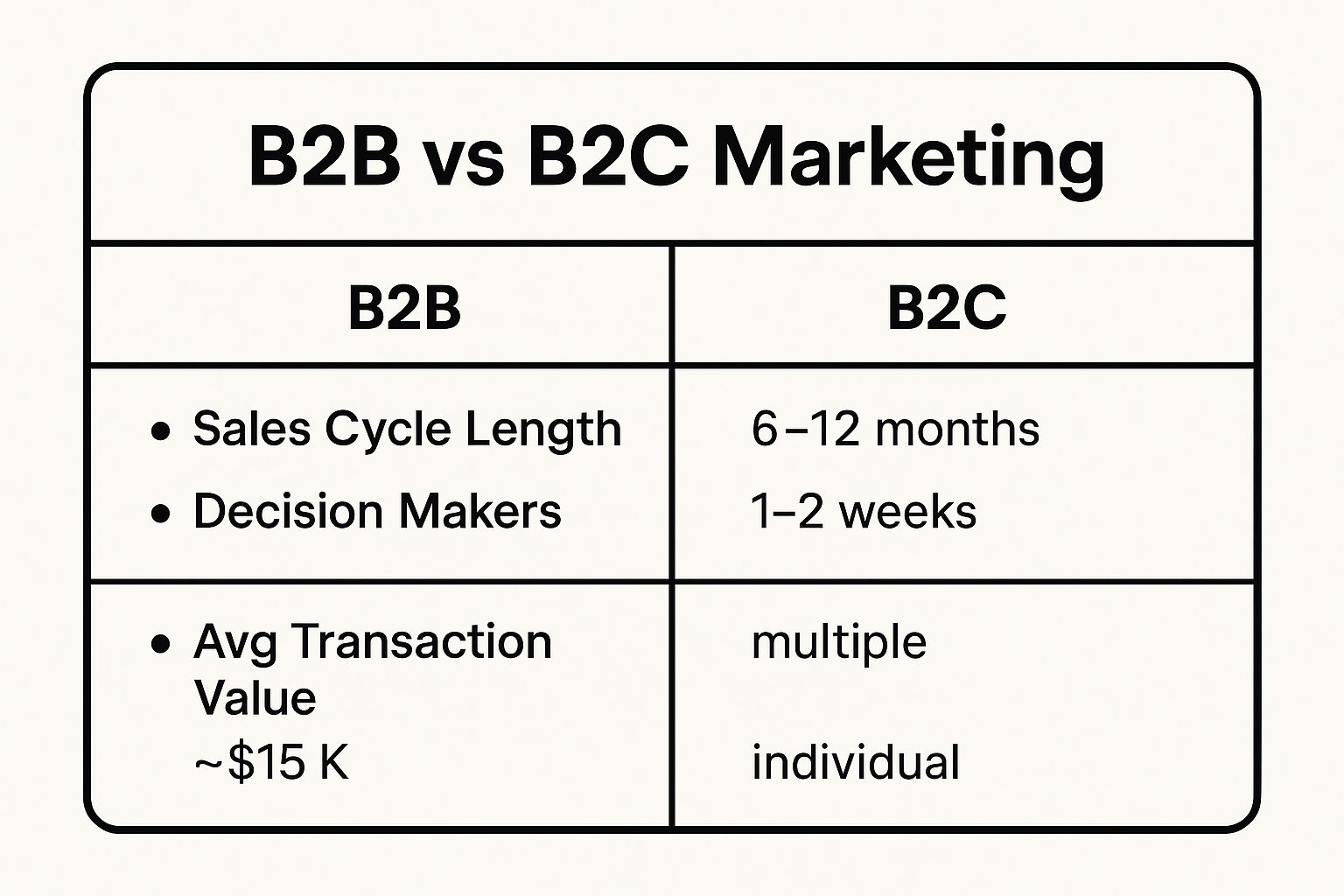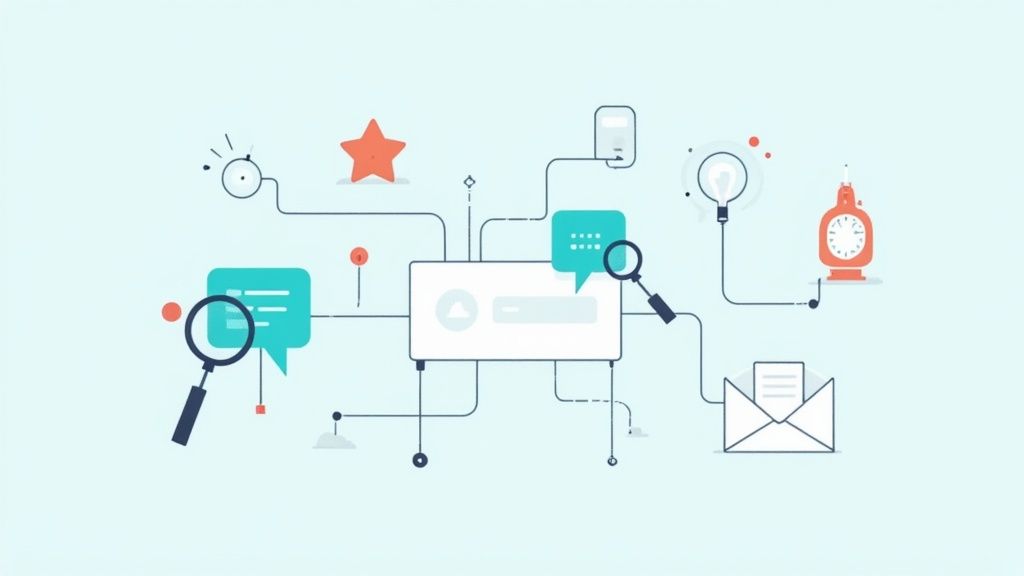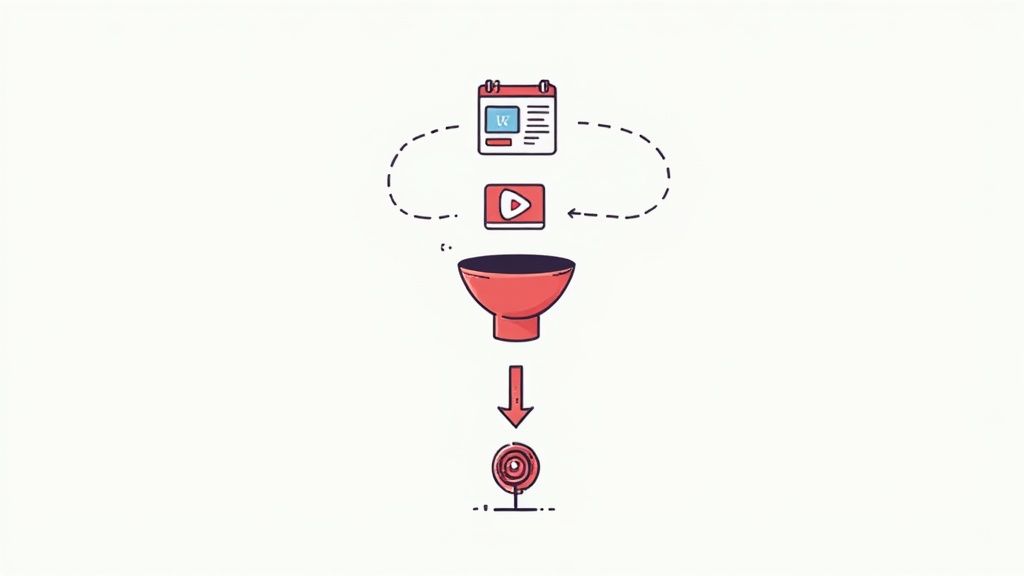
9 Key Marketing Interview Questions and Answers for 2025
Published
Ready to Land Your Dream Marketing Job? Start Here.
Navigating the marketing job market can be challenging, but thorough preparation is your greatest asset. Landing your dream role, whether in influencer marketing, digital strategy, or brand management, often comes down to one critical moment: the interview. Hiring managers are looking for more than just textbook definitions; they want to see how you think strategically, analyze data, and apply foundational marketing principles to real-world scenarios.
This guide breaks down nine of the most common and crucial marketing interview questions and answers. We move beyond generic advice to provide a framework for structuring your responses. You will learn not just what to say, but how to frame your answers with actionable insights, strategic thinking, and compelling examples drawn from your own experience. For additional interview practice, consider utilizing an AI-powered tool like Interviewpal to rehearse your delivery and refine your talking points.
Use this comprehensive resource to build your confidence, showcase your expertise, and make a lasting impression on your future employer. Let's dive in and get you ready for your next big opportunity.
1. What is the 4 P's of Marketing?
This is one of the most foundational marketing interview questions and answers you’ll encounter. The 4 P's of Marketing, also known as the marketing mix, is a framework used to develop a comprehensive strategy. It ensures all key elements influencing customer decisions are considered. Originated by E. Jerome McCarthy, this model helps marketers strategically position a product or service in the market.

The framework consists of four core components:
- Product: The item or service being sold. It must meet a specific customer need or demand.
- Price: The cost consumers pay. This determines profitability and affects customer perception.
- Place: Where the product is sold and distributed. Accessibility is key to reaching your target audience.
- Promotion: The marketing communication strategies used, such as advertising, public relations, and social media.
How to Answer This Question
When asked about the 4 P's, start by defining each component clearly. Then, demonstrate your strategic thinking by applying the framework to a real-world example. For instance, discuss Tesla:
- Product: Innovative, high-performance electric vehicles with cutting-edge technology.
- Price: Premium pricing strategy reflecting its advanced features and brand positioning.
- Place: A direct-to-consumer sales model using showrooms and online ordering, bypassing traditional dealerships.
- Promotion: Relies heavily on PR, word-of-mouth, and the personal brand of its CEO rather than traditional advertising.
For service-based businesses, you can also mention the extended 7 P's model, which adds People, Process, and Physical Evidence. This shows a deeper, more nuanced understanding of marketing principles. Use this framework as a checklist during campaign planning to ensure a balanced and effective strategy.
2. How do you measure the success of a marketing campaign?
This is a critical question among marketing interview questions and answers because it assesses your analytical skills and ability to connect marketing activities to business results. Measuring campaign success involves tracking key performance indicators (KPIs) against pre-defined objectives. A comprehensive approach looks beyond vanity metrics and focuses on data that demonstrates return on investment (ROI) and progress toward overarching business goals.
Effectively measuring a campaign means establishing clear, measurable objectives before launch. The choice of metrics depends entirely on the campaign's goals, whether they are to increase brand awareness, generate leads, drive sales, or improve customer loyalty. Popularized by platforms like Google Analytics and the growth hacking movement, this data-driven approach is now standard practice.
To demonstrate your expertise, structure your answer around a framework that connects objectives to specific metrics:
- Awareness: Measured by impressions, reach, social media engagement, and brand mentions.
- Consideration: Tracked through click-through rates (CTR), website traffic, and lead generation (e.g., downloads, sign-ups).
- Conversion: Assessed with conversion rates, customer acquisition cost (CAC), and sales revenue.
- Loyalty: Monitored via customer lifetime value (CLV), repeat purchase rate, and Net Promoter Score (NPS).
How to Answer This Question
Begin by stating the importance of setting SMART (Specific, Measurable, Achievable, Relevant, Time-bound) goals. Then, explain how you would select KPIs based on those goals. Provide a concrete example to showcase your thought process. For instance, when discussing an influencer marketing campaign for a new SaaS product:
- Objective: Generate 500 qualified leads (MQLs) in Q1.
- Awareness Metrics: Track influencer reach, impressions, and engagement rates on promotional content.
- Consideration Metrics: Monitor clicks to the landing page from unique tracking links and the number of demo sign-ups.
- Conversion Metrics: Measure the MQL-to-SQL (Sales Qualified Lead) conversion rate and the final customer acquisition cost.
Mentioning the need for proper attribution modeling (e.g., first-touch, last-touch, multi-touch) shows a sophisticated understanding. Conclude by emphasizing the importance of regular reporting and using insights to optimize future campaigns. This approach proves you are a results-oriented marketer. For more on this, you can explore a complete guide to influencer marketing strategy and its measurement.
3. Explain the difference between B2B and B2C marketing
This is another foundational item among marketing interview questions and answers, designed to test your understanding of audience, strategy, and execution. The core difference lies in the target audience: Business-to-Business (B2B) marketing targets other companies, while Business-to-Consumer (B2C) marketing targets individual customers. This fundamental distinction shapes every aspect of the marketing strategy, from messaging and channels to the sales cycle and relationship management.
The following infographic provides a quick reference, summarizing the key distinctions between the two marketing approaches.

The data highlights that B2B marketing involves longer, more complex sales cycles and higher transaction values, driven by multiple stakeholders.
- B2B Marketing: Focuses on logic, efficiency, and return on investment (ROI). The decision-making process is rational and involves multiple stakeholders (e.g., department heads, finance, executives). Trust is built through educational content, case studies, and thought leadership.
- B2C Marketing: Aims to connect with customers on an emotional level. Decisions are often made by an individual and are driven by desire, status, or immediate need. The goal is to build a memorable brand experience through storytelling and broad-reach advertising.
How to Answer This Question
Start by clearly defining both B2B and B2C marketing. Then, showcase your strategic depth by contrasting them with specific examples. For instance, compare Salesforce (B2B) with Nike (B2C):
- Salesforce (B2B): Targets businesses with content focused on improving efficiency and ROI. Their marketing involves detailed whitepapers, webinars, and a long sales process tailored to solving complex organizational problems.
- Nike (B2C): Sells a lifestyle and feeling of achievement to individuals. Their marketing uses emotional storytelling, celebrity endorsements, and social media campaigns to drive quick, individual purchase decisions.
Demonstrate a deeper understanding by discussing how channels and tactics differ. For example, LinkedIn and industry trade shows are crucial for B2B, while Instagram and TikTok are often more effective for B2C. Understanding these nuances is also essential when comparing strategies like affiliate marketing vs influencer marketing, as their application varies significantly between B2B and B2C contexts.
4. What is your approach to market research?
This question assesses your ability to make data-informed decisions rather than relying on assumptions. An effective approach to market research involves a systematic process for gathering, analyzing, and interpreting information about a target market, competitors, and industry trends. It is the foundation of any successful marketing strategy, ensuring that decisions are grounded in real-world insights, not just intuition.
Your answer should show that you understand the difference between primary research (gathering new data) and secondary research (using existing data). A strong approach combines both to create a comprehensive view. This is a common marketing interview question because it reveals your strategic and analytical capabilities.
A robust market research process typically includes:
- Defining Objectives: Clearly stating the problem you need to solve or the question you need to answer.
- Developing a Plan: Choosing the right methodologies, such as surveys, interviews, focus groups, or data analysis.
- Collecting Information: Executing the plan to gather relevant data.
- Analyzing Findings: Interpreting the data to identify patterns, trends, and key takeaways.
- Presenting Actionable Recommendations: Translating insights into clear, strategic steps for the business.
How to Answer This Question
Structure your answer by outlining your systematic approach. Start by emphasizing the importance of setting clear objectives. Then, discuss the methods you would use to achieve those objectives, providing a concrete example. Consider how Netflix uses viewing data (secondary) and A/B tests (primary) to inform content decisions.
Explain how you combine qualitative and quantitative data for a holistic view. When discussing your process, be ready to elaborate on how you gather insights using top audience research methods.
For example, you could structure your response like this:
- Objective: "First, I'd define the core business question. Are we trying to understand customer churn, or are we exploring a new market segment?"
- Methodology: "Next, I would select a mix of methods. I'd start with secondary research, like market reports and competitor analysis, to build a foundation. Then, I’d conduct primary research, like customer surveys or interviews, to fill in the gaps."
- Analysis & Action: "Finally, I would analyze the findings to identify actionable insights and present clear recommendations, such as 'Our research indicates a 20% increase in demand for eco-friendly packaging, so I recommend we pilot a sustainable option.'"
This demonstrates a logical, goal-oriented, and practical approach to using research to drive business results.
5. How do you develop buyer personas?
This is another common entry in our list of marketing interview questions and answers, as it tests your ability to understand and empathize with the target audience. Buyer personas are semi-fictional, research-based profiles that represent your ideal customers. Pioneered by figures like Tony Zambito and Adele Revella, they help marketers tailor strategies by humanizing data and focusing on customer motivations, goals, and pain points.
Creating effective personas involves a multi-step process that combines qualitative and quantitative data:
- Research: Gather data from customer surveys, interviews, website analytics, social media insights, and feedback from your sales and customer service teams.
- Identify Patterns: Analyze the data to find common characteristics, behaviors, and challenges among your audience segments.
- Build the Profile: Create a detailed profile for each key segment. Give them a name, job title, and include demographic information, goals, challenges, and motivations.
- Share and Utilize: Distribute the personas across all customer-facing departments, including marketing, sales, and product development, to ensure consistent messaging and a customer-centric approach.
How to Answer This Question
To answer effectively, outline your process and provide concrete examples. Explain that you would base personas on real data, not assumptions. Mention how you would limit the number to 3-5 primary personas to maintain focus and even create a negative persona to identify who not to target.
For instance, you could reference how HubSpot uses personas like 'Marketing Mary' to guide its content strategy or how Airbnb creates traveler personas based on trip purpose (e.g., 'Business Traveler Brian' vs. 'Family Vacation Fiona'). Show your understanding by stating that personas are not static; they should be regularly reviewed and updated as market trends and customer behaviors evolve. This demonstrates a strategic, data-driven, and adaptable marketing mindset.
6. What is your experience with digital marketing channels?
This question is designed to gauge your hands-on expertise and strategic understanding of the modern marketing landscape. Answering effectively requires you to demonstrate a comprehensive grasp of the various online channels used to reach and engage audiences. It's a core topic among marketing interview questions and answers, as it reveals your ability to translate strategy into tangible results across the digital ecosystem.

Digital marketing channels encompass a broad spectrum of tactics and platforms, typically categorized as:
- Paid Media: Channels where you pay for placement, such as Google Ads (PPC), social media ads (Facebook, Instagram, LinkedIn), and display advertising.
- Owned Media: Digital assets you control, including your company website, blog, email newsletters, and organic social media profiles.
- Earned Media: The organic exposure you gain through word-of-mouth, such as press mentions, customer reviews, social media shares, and influencer collaborations.
How to Answer This Question
To answer this question well, go beyond listing channels you've used. Instead, structure your response around a specific campaign or project. Explain the goal, the channels you selected, why you chose them, and the results you achieved. For instance, you could discuss how Dollar Shave Club used a viral video on YouTube (owned/earned media) to build massive brand awareness and drive subscriptions.
Showcase your strategic thinking by explaining how you integrate different channels. For example:
- Objective: Drive leads for a B2B SaaS product.
- Strategy: Use LinkedIn Ads (paid) to target specific job titles, driving them to a high-value blog post (owned).
- Nurturing: Capture their email via a content download and enroll them in an automated email sequence (owned).
- Optimization: Use analytics to track conversion rates from each channel and reallocate budget to the highest-performing ones.
This approach demonstrates not just your familiarity with the tools but also your ability to build a cohesive, data-driven strategy. Detailing your journey can also help hiring managers understand your career progression. Exploring a comprehensive digital marketing career path can provide context for your experience and future ambitions.
7. How do you handle a product launch?
This question tests your strategic planning, project management, and cross-functional collaboration skills, which are crucial for successful marketing roles. Interviewers want to see if you have a structured, comprehensive approach to introducing a new product to the market. A successful launch requires coordinating marketing, sales, product development, and customer support to create maximum impact.
Your answer should demonstrate an understanding of the entire launch lifecycle, from pre-launch buzz to post-launch analysis. A critical aspect of a marketing role is the successful introduction of new offerings. Exploring top new product launch strategies can provide valuable insights for your interview discussions and showcase your proactive learning.
A well-planned launch involves several key stages:
- Pre-Launch: Building anticipation through teaser campaigns, influencer outreach, and press previews.
- Launch Day: Executing a coordinated multi-channel push to maximize visibility and drive initial sales.
- Post-Launch: Analyzing performance data, gathering customer feedback, and optimizing the marketing strategy.
How to Answer This Question
When answering, outline a clear, step-by-step process. Avoid a generic response by using a specific example, either from your past experience or a well-known case study. For instance, discuss Peloton's launch strategy:
- Define the Target Audience: Focused on affluent, busy professionals seeking convenient, high-quality home fitness.
- Develop a Go-to-Market Strategy: Created an integrated ecosystem combining premium hardware (the bike), engaging software (live classes), and a strong community element.
- Set Clear Goals: Aimed for specific sales targets, media mentions, and user engagement metrics.
- Create a Timeline: Coordinated product availability, marketing campaigns, and retail showroom openings with clear milestones.
- Prepare for Post-Launch: Monitored community feedback, iterated on class content, and used user testimonials in future marketing.
This structured approach shows the interviewer that you can manage complexity, think strategically, and drive results from start to finish, a key competency for answering marketing interview questions and answers effectively.
8. What is content marketing and how do you create a content strategy?
This is a key question in modern marketing interviews, as it tests your understanding of building long-term audience relationships. Content marketing is a strategic approach focused on creating and distributing valuable, relevant, and consistent content. The goal is to attract and retain a clearly defined audience, ultimately driving profitable customer action by building trust and authority.

Popularized by pioneers like Joe Pulizzi and Ann Handley, it shifts the focus from direct selling to providing genuine value. This approach nurtures prospects through the buyer's journey, establishing your brand as a go-to resource. A successful content strategy involves several key steps:
- Define Goals & KPIs: Establish what you want to achieve (e.g., brand awareness, lead generation) and how you'll measure it (e.g., organic traffic, conversion rates).
- Identify Buyer Personas: Understand your target audience's pain points, questions, and content consumption habits.
- Content Planning & Creation: Develop a content calendar with topics that address audience needs at each stage of the buyer’s journey (Awareness, Consideration, Decision).
- Distribution & Promotion: Plan how you'll share your content across various channels like social media, email newsletters, and SEO.
How to Answer This Question
Start by defining content marketing succinctly. Then, outline the steps for creating a strategy, showcasing your systematic approach. Use a concrete example to illustrate your points. For instance, discuss HubSpot's strategy:
- Audience: Marketers and sales professionals at small to medium-sized businesses.
- Content: Provides immense value through its blog, free courses, and downloadable templates, addressing every conceivable marketing pain point.
- Strategy: Aligns content with the inbound methodology, using educational resources to attract users and then converting them into leads for its software.
- Measurement: Tracks everything from blog readership and social shares to lead conversions and customer acquisition cost.
Mentioning the importance of repurposing content (e.g., turning a blog post into a video, infographic, and social media series) demonstrates strategic efficiency and a deeper understanding of maximizing content value. This shows you can deliver a comprehensive and effective content program.
9. How do you approach competitor analysis?
This is one of the most strategic marketing interview questions and answers you can prepare for, as it reveals your analytical and decision-making capabilities. A strong answer shows you can systematically identify, evaluate, and monitor competitors to inform business strategy. This process helps uncover market opportunities, anticipate competitive threats, and benchmark your own performance.
A thorough competitor analysis framework typically involves several key stages:
- Identification: Pinpointing both direct (offering similar products to the same audience) and indirect (solving the same problem with a different solution) competitors.
- Data Collection: Gathering intelligence on their products, pricing, positioning, and promotional tactics.
- Analysis: Evaluating their strengths and weaknesses using a framework like SWOT (Strengths, Weaknesses, Opportunities, Threats).
- Action: Translating the insights into actionable marketing strategies, such as adjusting pricing or launching a new feature.
How to Answer This Question
Begin by outlining your systematic approach. Explain how you gather information from various sources like their website, social media, customer reviews, and industry reports. Then, provide a concrete example to illustrate your process. For instance, you could discuss how Netflix analyzes its rivals:
- Competitors: Disney+, Hulu, and HBO Max.
- Analysis: Netflix would track their content libraries (original vs. licensed), subscription pricing tiers, user experience, and global expansion strategies.
- Actionable Insights: This analysis might lead Netflix to invest more in a specific genre of original content that competitors are neglecting or adjust its international pricing to remain competitive.
To show advanced thinking, mention using competitive intelligence tools like SEMrush or Ahrefs for digital insights. Emphasize that competitor analysis isn't a one-time project but an ongoing process that requires regular monitoring to adapt to market changes effectively. This demonstrates a proactive, data-driven mindset.
Marketing Interview Q&A Comparison Matrix
| Item | Implementation Complexity 🔄 | Resource Requirements ⚡ | Expected Outcomes 📊 | Ideal Use Cases 💡 | Key Advantages ⭐ |
|---|---|---|---|---|---|
| What is the 4 P's of Marketing? | Low 🔄 | Low ⚡ | Comprehensive marketing strategy foundation 📊 | Developing overall marketing plans, traditional product marketing | Easy to understand; systematic; widely recognized ⭐ |
| How do you measure the success of a marketing campaign? | Medium 🔄 | Medium ⚡ | Data-driven insights; campaign optimization 📊 | Evaluating marketing effectiveness, budgeting, accountability | Enables data-driven decisions and continuous improvements ⭐ |
| Explain the difference between B2B and B2C marketing | Medium 🔄 | Medium ⚡ | Targeted marketing strategies; audience segmentation 📊 | Tailoring communication for varied audiences; distinct sales cycles | Clarifies audience focus; improves messaging relevance ⭐ |
| What is your approach to market research? | Medium to High 🔄 | Medium to High ⚡ | Market insights; risk reduction; opportunity ID 📊 | Informing strategic decisions, new product development | Reduces risks; uncovers market trends; validates assumptions ⭐ |
| How do you develop buyer personas? | Medium 🔄 | Medium ⚡ | Customized customer profiles for targeted marketing 📊 | Enhancing personalization; aligning sales/marketing efforts | Improves targeting and engagement; aligns teams ⭐ |
| What is your experience with digital marketing channels? | Medium 🔄 | Medium ⚡ | High reach; measurable ROI; scalable campaigns 📊 | Multi-channel digital campaigns; audience engagement | Precise targeting; real-time optimization; cost-effective ⭐ |
| How do you handle a product launch? | High 🔄 | High ⚡ | Market buzz; early adoption; strong positioning 📊 | Introducing new products, coordinated cross-team efforts | Builds momentum; drives initial sales; brand credibility ⭐ |
| What is content marketing and how do you create a content strategy? | Medium 🔄 | Medium ⚡ | Brand authority; lead generation; SEO benefits 📊 | Long-term brand building; inbound marketing strategies | Builds trust; cost-effective; creates lasting value ⭐ |
| How do you approach competitor analysis? | Medium 🔄 | Medium ⚡ | Strategic insights; market positioning; threat ID 📊 | Market intelligence; strategic planning | Identifies gaps; anticipates competition; validates strategies ⭐ |
Take the Next Step in Your Marketing Career
Navigating the landscape of marketing interview questions and answers is more than an exercise in memorization; it's a strategic process of showcasing your unique value proposition. The questions we've explored, from foundational concepts like the 4 P's to complex processes like handling a product launch, all serve a single purpose: to reveal how you think, strategize, and execute. Acing your interview hinges not on reciting textbook definitions, but on weaving your personal experiences, data-driven successes, and forward-thinking insights into a compelling narrative that proves you are the solution to the company's challenges.
The most powerful takeaway is that every question is an opportunity. When asked about measuring campaign success, you're not just listing metrics; you're demonstrating your ability to connect marketing activities directly to business revenue and growth. When you explain your approach to competitor analysis, you're showcasing your strategic foresight and your capacity to carve out a unique space in a crowded market.
From Preparation to Performance
True mastery of these concepts moves beyond the theoretical and into the practical. The key is to transform your knowledge into a performance that demonstrates your capabilities. Here are the actionable steps to bridge that gap:
- Build Your "Proof Portfolio": For each question covered, compile specific, quantifiable examples from your past roles. Instead of saying you "improved engagement," state that you "launched a content series that increased organic engagement by 45% and generated 200 MQLs in Q3."
- Practice with the STAR Method: Rehearse your answers using the Situation, Task, Action, Result (STAR) framework. This structure ensures your responses are concise, logical, and impact-oriented, preventing you from rambling and helping you clearly articulate your contributions.
- Conduct Proactive Research: Don't wait for the interview to think about the company's marketing. Before you even speak to a recruiter, perform a mini-audit of their current strategy. Analyze their buyer personas, content, and competitive positioning. This allows you to tailor your answers with specific, relevant insights that show you've already started thinking like a member of their team.
Your Career-Defining Moment
Ultimately, preparing for these marketing interview questions and answers is an investment in your professional future. It forces you to codify your skills, quantify your achievements, and articulate your strategic vision. This preparation not only empowers you to walk into any interview with confidence but also clarifies what you truly want in your next role, enabling you to identify the opportunities that align perfectly with your ambitions and expertise.
Now that you're armed with the strategies to impress any hiring manager, it's time to find the role where you can make a real impact. Explore the curated opportunities on Influencer Marketing Jobs, a premier job board specializing in connecting elite marketing talent with leading brands and agencies. Your next great career move is waiting for you.